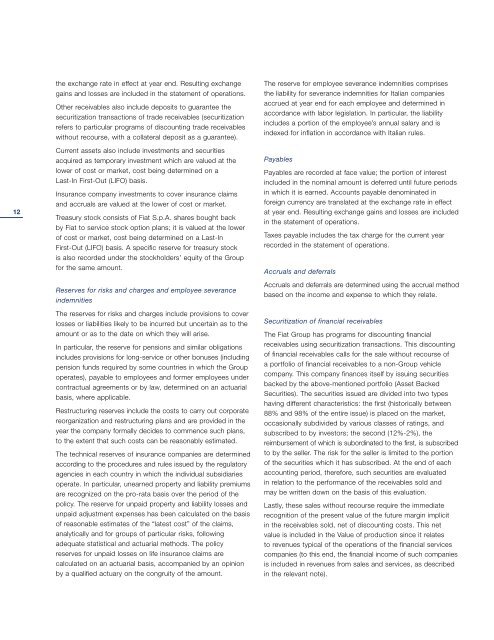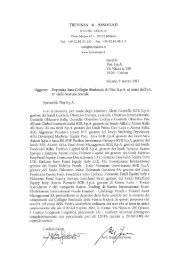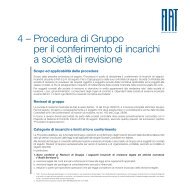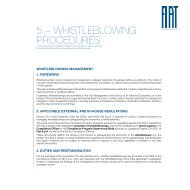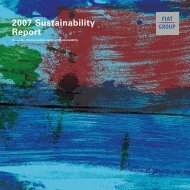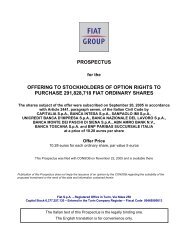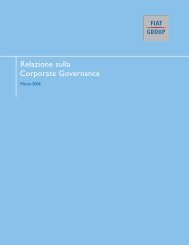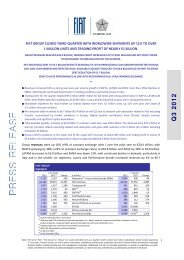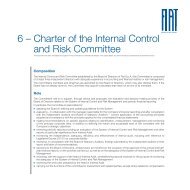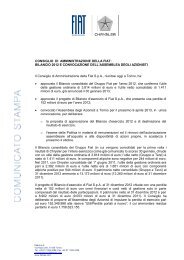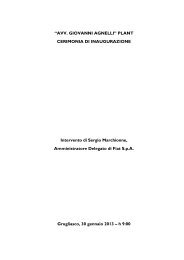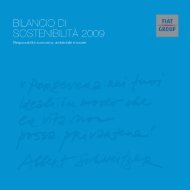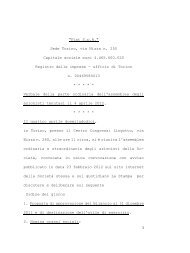THE FIAT GROUP IN - Fiat SpA
THE FIAT GROUP IN - Fiat SpA
THE FIAT GROUP IN - Fiat SpA
Create successful ePaper yourself
Turn your PDF publications into a flip-book with our unique Google optimized e-Paper software.
12<br />
12<br />
the exchange rate in effect at year end. Resulting exchange<br />
gains and losses are included in the statement of operations.<br />
Other receivables also include deposits to guarantee the<br />
securitization transactions of trade receivables (securitization<br />
refers to particular programs of discounting trade receivables<br />
without recourse, with a collateral deposit as a guarantee).<br />
Current assets also include investments and securities<br />
acquired as temporary investment which are valued at the<br />
lower of cost or market, cost being determined on a<br />
Last-In First-Out (LIFO) basis.<br />
Insurance company investments to cover insurance claims<br />
and accruals are valued at the lower of cost or market.<br />
Treasury stock consists of <strong>Fiat</strong> S.p.A. shares bought back<br />
by <strong>Fiat</strong> to service stock option plans; it is valued at the lower<br />
of cost or market, cost being determined on a Last-In<br />
First-Out (LIFO) basis. A specific reserve for treasury stock<br />
is also recorded under the stockholders’ equity of the Group<br />
for the same amount.<br />
Reserves for risks and charges and employee severance<br />
indemnities<br />
The reserves for risks and charges include provisions to cover<br />
losses or liabilities likely to be incurred but uncertain as to the<br />
amount or as to the date on which they will arise.<br />
In particular, the reserve for pensions and similar obligations<br />
includes provisions for long-service or other bonuses (including<br />
pension funds required by some countries in which the Group<br />
operates), payable to employees and former employees under<br />
contractual agreements or by law, determined on an actuarial<br />
basis, where applicable.<br />
Restructuring reserves include the costs to carry out corporate<br />
reorganization and restructuring plans and are provided in the<br />
year the company formally decides to commence such plans,<br />
to the extent that such costs can be reasonably estimated.<br />
The technical reserves of insurance companies are determined<br />
according to the procedures and rules issued by the regulatory<br />
agencies in each country in which the individual subsidiaries<br />
operate. In particular, unearned property and liability premiums<br />
are recognized on the pro-rata basis over the period of the<br />
policy. The reserve for unpaid property and liability losses and<br />
unpaid adjustment expenses has been calculated on the basis<br />
of reasonable estimates of the “latest cost” of the claims,<br />
analytically and for groups of particular risks, following<br />
adequate statistical and actuarial methods. The policy<br />
reserves for unpaid losses on life insurance claims are<br />
calculated on an actuarial basis, accompanied by an opinion<br />
by a qualified actuary on the congruity of the amount.<br />
The reserve for employee severance indemnities comprises<br />
the liability for severance indemnities for Italian companies<br />
accrued at year end for each employee and determined in<br />
accordance with labor legislation. In particular, the liability<br />
includes a portion of the employee’s annual salary and is<br />
indexed for inflation in accordance with Italian rules.<br />
Payables<br />
Payables are recorded at face value; the portion of interest<br />
included in the nominal amount is deferred until future periods<br />
in which it is earned. Accounts payable denominated in<br />
foreign currency are translated at the exchange rate in effect<br />
at year end. Resulting exchange gains and losses are included<br />
in the statement of operations.<br />
Taxes payable includes the tax charge for the current year<br />
recorded in the statement of operations.<br />
Accruals and deferrals<br />
Accruals and deferrals are determined using the accrual method<br />
based on the income and expense to which they relate.<br />
Securitization of financial receivables<br />
The <strong>Fiat</strong> Group has programs for discounting financial<br />
receivables using securitization transactions. This discounting<br />
of financial receivables calls for the sale without recourse of<br />
a portfolio of financial receivables to a non-Group vehicle<br />
company. This company finances itself by issuing securities<br />
backed by the above-mentioned portfolio (Asset Backed<br />
Securities). The securities issued are divided into two types<br />
having different characteristics: the first (historically between<br />
88% and 98% of the entire issue) is placed on the market,<br />
occasionally subdivided by various classes of ratings, and<br />
subscribed to by investors; the second (12%-2%), the<br />
reimbursement of which is subordinated to the first, is subscribed<br />
to by the seller. The risk for the seller is limited to the portion<br />
of the securities which it has subscribed. At the end of each<br />
accounting period, therefore, such securities are evaluated<br />
in relation to the performance of the receivables sold and<br />
may be written down on the basis of this evaluation.<br />
Lastly, these sales without recourse require the immediate<br />
recognition of the present value of the future margin implicit<br />
in the receivables sold, net of discounting costs. This net<br />
value is included in the Value of production since it relates<br />
to revenues typical of the operations of the financial services<br />
companies (to this end, the financial income of such companies<br />
is included in revenues from sales and services, as described<br />
in the relevant note).


